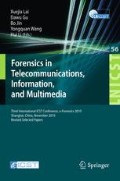Abstract
Fragmented File carving is an important technique in Digital Forensics to recover files from their fragments in the absence of the file system allocation information. In this paper, the fragmented file carving problem is formulated as a graph theoretic problem. Using this model, we describe two algorithms, “Best Path Search” and “High Fragmentation Path Search”, to perform file reconstruction and recovery. The best path search algorithm is a deterministic technique to recover the best file construction path. We show that this technique is more efficient and accurate than existing brute force techniques. In addition, a test was carried out to recover 10 files scattered into their fragments. The best path search algorithm was able to successful recover all of them back to their original state. The high fragmentation path search technique involves a trade-off between the final score of the constructed path of the file and the file recovery time to allow a faster recovery process for highly fragmented files. Analysis show that the accurate eliminations of paths have an accuracy of up to greater than 85%.
Access this chapter
Tax calculation will be finalised at checkout
Purchases are for personal use only
Preview
Unable to display preview. Download preview PDF.
References
Leiserson, C.E.: Introduction to algorithms. MIT Press, Cambridge (2001)
da Gama Leito, H.C., Soltfi, J.: Automatic reassembly of irregular fragments. In: Univ. of Campinas, Tech. Rep. IC-98-06 (1998)
da Gama Leito, H.C., Soltfi, J.: A multiscale method for the reassembly of two-dimensional fragmented objects. IEEE Transections on Pattern Analysis and Machine Intelligence 24 (September 2002)
Shanmugasundaram, K., Memon, N.: Automatic reassembly of document fragments via context based statistical models. In: Proceedings of the 19th Annual Computer Security Applications Conference, p. 152 (2003)
Shanmugasundaram, K., Memon, N.: Automatic reassembly of document fragments via data compression. Presented at the 2nd Digital Forensics Research Workshop, Syracuse (July 2002)
Cohen, M.I.: Advanced jpeg carving. In: Proceedings of the 1st International Conference on Forensic Applications and Techniques in Telecommunications, Information, and Multimedia and Workshop, Article No.16 (2008)
Cohen, M.I.: Advanced carving techniques. Digital Investigation 4(supplement 1), 2–12 (2007)
Memon, N., Pal, A.: Automated reassembly of file fragmented images using greedy algorithms. IEEE Transactions on Image Processing, 385–393 (February 2006)
Sablatnig, R., Menard, C.: On finding archaeological fragment assemblies using a bottom-up design. In: Proc. of the 21st Workshop of the Austrain Association for Pattern Recognition Hallstatt, Austria, Oldenburg, Wien, Muenchen, pp. 203–207 (1997)
Garfinkel, S.: Carving contiguous and fragmented files with fast object validation. In: Proceedings of the 2007 Digital Forensics Research Workshop, DFRWS, Pittsburgh, PA (August 2007)
Martucci, S.A.: Reversible compression of hdtv images using median adaptive prediction and arithmetic coding. In: IEEE International Symposium on Circuits and Systems, pp. 1310–1313 (1990)
Kampel, M., Sablatnig, R., Costa, E.: Classification of archaeological fragments using profile primitives. In: Computer Vision, Computer Graphics and Photogrammetry - a Common Viewpoint, Proceedings of the 25th Workshop of the Austrian Association for Pattern Recognition (OAGM), pp. 151–158 (2001)
Pal, A., Sencar, H.T., Memon, N.: Detecting file fragmentation point using sequential hypothesis testing. In: Proceedings of the Eighth Annual DFRWS Conference. Digital Investigation, vol. 5(supplement 1), pp. S2–S13 (September 2008)
Pal, A., Shanmugasundaram, K., Memon, N.: Automated reassembly of fragmented images. Presented at ICASSP (2003)
Stemmer, W.P.: DNA shuffling by random fragmentation and reassembly: in vitro recombination for molecular evolution. Proc. Natl. Acad. Sci. (October 25, 1994)
Author information
Authors and Affiliations
Editor information
Editors and Affiliations
Rights and permissions
Copyright information
© 2011 ICST Institute for Computer Science, Social Informatics and Telecommunications Engineering
About this paper
Cite this paper
Ying, HM., Thing, V.L.L. (2011). A Novel Inequality-Based Fragmented File Carving Technique. In: Lai, X., Gu, D., Jin, B., Wang, Y., Li, H. (eds) Forensics in Telecommunications, Information, and Multimedia. e-Forensics 2010. Lecture Notes of the Institute for Computer Sciences, Social Informatics and Telecommunications Engineering, vol 56. Springer, Berlin, Heidelberg. https://doi.org/10.1007/978-3-642-23602-0_3
Download citation
DOI: https://doi.org/10.1007/978-3-642-23602-0_3
Publisher Name: Springer, Berlin, Heidelberg
Print ISBN: 978-3-642-23601-3
Online ISBN: 978-3-642-23602-0
eBook Packages: Computer ScienceComputer Science (R0)

